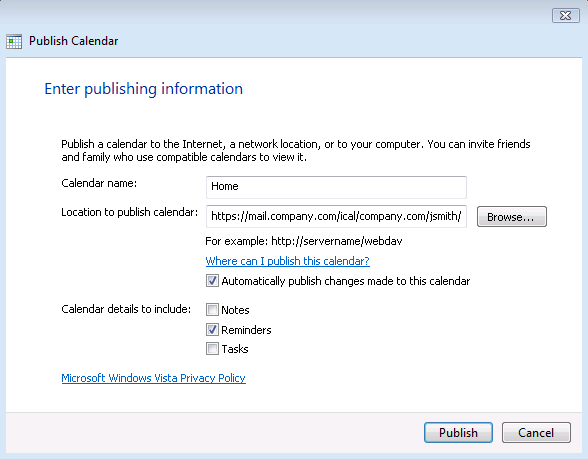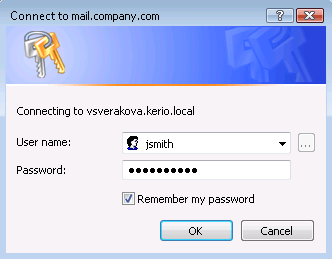Calendars can be published to the following stores:
to a personal account in Kerio Connect,
to an account of another Kerio Connect user (username and password are required unless the user creates a new calendar folder and shares it),
to any WebDAV server in the Internet
In their stores on the server, published calendars are available for reading only and it is therefore not possible to edit events or add new ones.
Calendars can be published through the menu. This opens a dialog (see figure 7.3 Calendar publishing), where URL address can be specified and other publishing parameters can be set:
- Calendar name
Name of the current calendar name is automatically filled in. It is possible to enter name of any calendar included in Windows Calendar.
- Location to publish calendar
URL location where the calendar will be published must be specified in one of the following ways:
To publish a calendar in the root folder (of a particular mailbox), enter URL in the following format:
https://server_name/icalfor example:
https://mail.company.com/icalTo publish a calendar in the
calendarfolder (of a particular mailbox), enter URL in the following format:https://server_name/ical/calendar
- Automatically publish changes made to this calendar
This option enables/disables automatic update of the published calendar. If this option is enabled, each change performed in Windows Calendar is automatically applied also in the calendar saved on the server.
- Calendar details to include
Several options are offered:
Notes — enables synchronization of notes attached to events.
Reminders — includes reminders in the synchronization process. However, publishing of reminders is not recommended. Calendars on the web are available only for reading and it will be therefore not possible to close subscribed reminders.
Tasks — not supported in Kerio Connect.
Clicking on the button opens a window for connection to the email account by user password. It is recommended to specify username including the domain even if the user's account is located in the primary domain (see figure 7.4 Connection to the email account). After successful verification of the user information, the calendar is published in the Kerio Connect's store.

